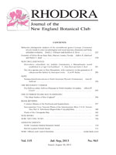
RHODORA
Scope & Guideline
Nurturing Insights in Botanical Studies
Introduction
Aims and Scopes
- Floristic Studies:
The journal publishes comprehensive floristic surveys that document plant species in specific regions, contributing to the understanding of biodiversity and conservation needs. - Taxonomic Research:
RHODORA features studies that clarify plant taxonomy, including descriptions of new species, revisions of existing classifications, and nomenclatural updates. - Ecological Investigations:
Research on the ecological relationships between plants and their environments, including studies on plant communities, phenology, and the impacts of invasive species. - Historical Botany:
The journal highlights the historical aspects of botany, including reviews of herbarium specimens and contributions to the understanding of plant distribution over time. - Conservation and Management:
Papers addressing conservation strategies for rare and endangered plants, as well as management practices for maintaining biodiversity in specific ecosystems.
Trending and Emerging
- Phenological Studies:
There is an increasing interest in the phenology of plant species, particularly in the context of climate change and its effects on flowering and fruiting times. - Conservation Biology:
Research concerning conservation efforts for rare and endangered species has gained prominence, reflecting a growing awareness of the need to protect biodiversity. - Ecological Community Dynamics:
Emerging studies focus on the dynamics of plant communities, including the impacts of climate change and habitat alteration on community structure and function. - Genetic and Molecular Studies:
An uptick in the use of genetic markers for species identification and taxonomy suggests a trend towards integrating molecular approaches in traditional botanical research. - Wetland and Aquatic Plant Studies:
There is a noticeable increase in research related to wetland and aquatic plants, highlighting their ecological importance and the need for conservation efforts in these critical habitats.
Declining or Waning
- Invasive Species Studies:
While earlier volumes included numerous studies on nonnative plant species, there appears to be a decrease in this focus, possibly due to a saturation of the topic or a shift towards more ecological or conservation-oriented research. - General Plant Physiology:
Research specifically centered on plant physiology has decreased, with fewer studies published on physiological processes compared to ecological and taxonomic research. - Historical Accounts of Botanical Exploration:
Although historical perspectives were once a significant part of the journal, recent issues show a decline in papers that explore the history of botanical exploration and documentation.
Similar Journals
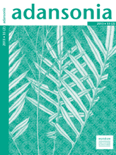
ADANSONIA
Pioneering discoveries in plant science since 2000.ADANSONIA is a distinguished, peer-reviewed open access journal dedicated to advancing the field of plant science. Published by the Publications Scientifiques du Museum in Paris since 2000, this journal serves as a critical platform for sharing innovative research and discoveries in botany, ecology, and related disciplines. With its ISSN 1280-8571 and E-ISSN 1639-4798, ADANSONIA boasts a notable Scopus rank of #383 in the Agricultural and Biological Sciences category and a 2023 category quartile ranking of Q3 in Plant Science, indicating a meaningful contribution to the academic community. The journal's scope encompasses a broad range of topics, making it a vital resource for researchers, professionals, and students alike who are exploring the complexities of plant biology. Based in France, ADANSONIA not only enhances visibility for groundbreaking research but also facilitates open communication amongst scholars, ensuring that knowledge on plant science is accessible worldwide. Located at CP 39-57, Rue Cuvier, F-75231 Paris Cedex 05, France, this journal stands as a testament to the collaborative efforts in the pursuit of scientific excellence in plant sciences.
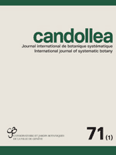
CANDOLLEA
Exploring the Depths of Ecology and Plant Science.CANDOLLEA is a distinguished academic journal published by the Conservatoire et Jardin Botaniques Ville Genève, focusing on the fields of Ecology, Evolution, Behavior, Systematics, and Plant Science. With an ISSN of 0373-2967, this journal serves as a vital platform for researchers, professionals, and students aiming to deepen their understanding and contribute to the scientific discourse surrounding botanical research and ecosystem dynamics. Since its convergence in 2000, CANDOLLEA has trodden the path of scholarly excellence, currently residing in the Q3 quartile for both Ecology and Plant Science in 2023. Although it does not currently offer open access, the journal plays a critical role in disseminating valuable findings and innovative methodologies that shape contemporary ecological and botanical studies. The journal is located in Switzerland at CASE POSTALE 60, CH-1292 CHAMBESY, serving as a beacon for scholars dedicated to advancing their expertise in environmental and plant sciences.

BRITTONIA
Illuminating Plant Biology for a Greener TomorrowBRITTONIA, published by Springer, stands as a reputable journal dedicated to advancing the fields of botany and plant sciences. With a storied history dating back to 1931, this journal has evolved to embrace contemporary research spanning various aspects of plant biology, ecology, and systematics. Focusing on a comprehensive analysis of both ecological interactions and plant systematics, BRITTONIA plays a crucial role in disseminating knowledge among researchers and professionals committed to understanding plant life and its environmental contexts. Despite its open access status being currently unavailable, the journal ensures wide accessibility through institutional subscriptions. In the latest rankings, it proudly holds a Q2 category in Plant Science and a Q3 category in Ecology, Evolution, Behavior, and Systematics, indicating its growing influence and academic rigor. Researchers and students alike will find BRITTONIA an essential resource for the latest findings and discussions in plant sciences.

GAYANA BOTANICA
Advancing plant science one article at a time.GAYANA BOTANICA is a prominent academic journal that specializes in the fields of Ecology, Horticulture, and Plant Science, published by EDICIONES UNIV, CONCEPCION in Chile. Established in 1981, this journal has become a vital resource for researchers and professionals seeking to advance their knowledge and contribute to the understanding of botanical sciences, offering a diverse range of articles that explore the ecology of plants, horticultural practices, and innovative plant science methodologies. Although it currently holds a Q4 quartile ranking in its categories, the journal’s commitment to disseminating valuable scientific findings continues to strengthen its relevance in the field. With its focus on promoting original research and fostering dialogue among scholars, GAYANA BOTANICA plays an essential role in supporting the global scientific community. We invite researchers, academics, and students to engage with its content and explore advancements that are shaping the future of plant sciences.

BANGLADESH JOURNAL OF BOTANY
Showcasing Bangladesh's Unique Botanical HeritageBANGLADESH JOURNAL OF BOTANY is a prominent publication in the field of plant sciences, dedicated to advancing research and knowledge within the botanical community. Published by the BANGLADESH BOTANICAL SOC, this journal serves as a vital platform for researchers and scholars seeking to disseminate their findings related to plant biology, ecology, and conservation practices, particularly within the unique context of Bangladesh's diverse flora. With an ISSN of 0253-5416 and an E-ISSN of 2079-9926, the journal encompasses a wide scope of topics, reflecting interdisciplinary approaches in botanical research. Since its inception, with convergence periods from 1996 to 2001 and from 2003 to 2024, it has garnered recognition, positioned in the Q4 category in the Plant Science field with a ranking of #459/516 in Scopus, indicating its contribution to the field despite its developing impact. Operating within Bangladesh, at the UNIV DACCA DEPT BOTANY, the journal provides a crucial insight into the ecological and agricultural implications of plant studies in the region, catering to the needs of academics, professionals, and students eager to engage with contemporary botanical research.

Botany
Advancing plant science through interdisciplinary insight.Botany is a premier academic journal published by Canadian Science Publishing, dedicated to advancing the understanding of plant sciences and ecological systems. With an ISSN of 1916-2790 and an E-ISSN of 1916-2804, this journal has established itself as a respected publication in the fields of Ecology, Evolution, Behavior and Systematics, and Plant Science, reflected in its 2023 Q2 and Q3 rankings. Covering a wide range of topics, Botany is committed to fostering interdisciplinary research, promoting innovative methodologies, and disseminating significant findings from both theoretical and applied perspectives. Based in Ottawa, Canada, the journal is open access, ensuring that high-quality research is accessible to a global audience, thereby playing a crucial role in the dissemination of knowledge in the scientific community. With convergence years from 2008 to 2024, it continues to evolve alongside the scientific advancements in botanical studies, making it an essential resource for researchers, professionals, and students alike.
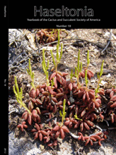
HASELTONIA
Advancing Knowledge in Plant ScienceHASELTONIA is a distinguished journal published by the CACTUS SUCCULENT SOC AMER INC, focusing on the field of plant science with particular emphasis on cacti and succulent plants. With an ISSN of 1070-0048 and an E-ISSN of 1938-2898, this journal has carved a niche for itself in the academic community, boasting a 2023 Scopus rank of #204 out of 516 in Agricultural and Biological Sciences, placing it in the 60th percentile. HASELTONIA spans several converged years from 2002 through 2024, reflecting its commitment to publishing pertinent and timely research. This journal is recognized for its significant contribution to the understanding and conservation of succulent flora and is classified in the Q2 category in Plant Science, indicating a solid impact in the field. HASELTONIA aims to promote research collaboration, disseminate innovative findings, and foster knowledge sharing among researchers, professionals, and students alike, making it an essential resource for anyone dedicated to the study and appreciation of plant diversity.
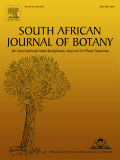
SOUTH AFRICAN JOURNAL OF BOTANY
Illuminating the Path for Plant Science DiscoveriesThe SOUTH AFRICAN JOURNAL OF BOTANY, published by Elsevier, is a distinguished peer-reviewed journal that serves as an essential platform for the dissemination of high-quality research in the field of plant science. With an ISSN of 0254-6299 and an E-ISSN of 1727-9321, this journal has been a vital contributor to the scientific community since its inception in 1982, continuing to publish pivotal research findings up to 2024. Recognized in the Q2 category of Plant Science for 2023, and ranked 106 out of 516 in Scopus, this journal occupies the 79th percentile in its field, reflecting a strong commitment to advancing botanical sciences. Although it is not an open-access publication, it provides crucial insights and advancements that benefit researchers, professionals, and students alike. As the journal continues to evolve, it remains an invaluable resource for those dedicated to exploring the complexities of plant biology within the broader scope of agricultural and biological sciences.

PHYTON-ANNALES REI BOTANICAE
Advancing plant science through rigorous research.PHYTON-ANNALES REI BOTANICAE is a distinguished journal dedicated to the fields of plant science and ecology, published by Ferdinand Berger Soehne. With its origins tracing back to 1994, this journal has carved a niche in disseminating vital research findings and innovative studies pertaining to botany and environmental biology, despite its coverage being discontinued in Scopus since 2016. The journal's impact extends across various disciplines, reflected in its rankings within the categories of Agricultural and Biological Sciences and Environmental Science, underscoring its commitment to advancing knowledge in plant sciences. While it is not an open-access journal, its rigorous peer-review process ensures high-quality research that is valuable for researchers, professionals, and students alike. Located in Horn, Austria, PHYTON serves as a pivotal platform for sharing significant contributions to the field, fostering a deeper understanding of plant biology and ecology.

Willdenowia
Advancing botanical knowledge, one article at a time.Willdenowia is a prestigious scientific journal published by the Botanischer Garten & Botanische Museum Berlin-Dahlem, dedicated to advancing the field of botany and plant sciences. With an ISSN of 0511-9618, this journal has established itself as a crucial platform for researchers, practitioners, and students interested in ecology, evolution, behavior, systematics, and plant science. The journal boasts an impactful reputation, evidenced by its impressive Q1 and Q2 quartile rankings in Plant Science and Ecology, Evolution, Behavior and Systematics respectively, as well as notable Scopus rankings, placing it within the top quartiles of its categories. Although access is not open, articles published in Willdenowia contribute significantly to the global body of botanical research, making it an essential resource for anyone looking to deepen their understanding of plant biology and related ecological disciplines. The journal has continuously evolved since its inception and aims to facilitate interdisciplinary collaboration and knowledge dissemination in the life sciences.